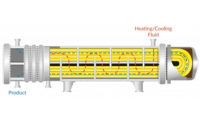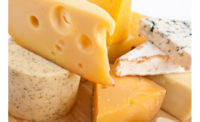Located near the North Yorkshore village of Holmefirth, Longley Farm boasts a quality Jersey cow herd and tops up demand with milk from as many as 40 trusted farmers around the U.K. The milk is used in its award-winning range of dairy products, including butter, cream, buttermilk, yogurt, cottage cheese, crème fraîche, sour cream and fromage frais.
The farm also makes its own ice cream, together with a traditional specialty Yorkshire Curd. Longley Farm is the world’s leading commercial manufacturer of this uncooked fresh curd product, which is the key ingredient in a traditional Yorkshire curd tart.
All of Longley Farm’s products are made without the use of artificial additives, colorings, preservatives or stabilizers and are sold in local shops and U.K. supermarkets. They have also found favor with restaurants and leading chefs, including Jamie Oliver and Raymond Blanc.
The need for heat exchangers
Like most other dairies, the factory operates a number of heat exchangers to remove the heat from processing and manufacturing its dairy products, which must be chilled for sale. Most of these are of a traditional plate design, which are fine for simple heating or cooling purposes.
But recent upgrades include new corrugated tube-type heat exchangers. Although the initial capital costs of tubular heat exchangers are higher than those for simpler plate alternatives, over the course of their operational life, the tubular heat exchangers can prove to be much more economical, improving process efficiencies by reusing heat and helping maintain the quality of the end product. These tubular units overcome some of the limitations of plate heat exchangers, including the relatively high pump pressures required, while also reducing maintenance costs over the life of the unit.
“We have a number of HRS heat exchangers which are integral to our operation in a number of ways,” explained Konrad Schwoch, Longley Farm operations and technical manager. “We use what we would consider a standard heat exchanger for cooling processes, but we now have two more sophisticated systems from HRS.”
Benefits of corrugated tubes
These new HRS heat exchangers incorporate corrugated tubes, which provide a number of advantages over flat plate or smooth tube types. The biggest advantage is that heat transfer is increased, particularly at higher flow rates, meaning that less heat transfer area is required, resulting in a shorter, more compact design, together with associated cost savings. This also results in gentler handling of the product during the cooling phase, which is crucial for fresh cream production.
“For a cream process, we want the cooling profile to be very gentle and we want to agitate the cream as little as possible,” Schwoch said. “That was the main reason for using a tubular heat exchanger, as it is gentler on the cream and improves product quality.”
He also added that if you “beat up” cream by pumping it over and over, you make butter, which is specifically not what is required in this situation. Maintaining the ideal temperature of the cream throughout the process is also vital for maintaining the quality of the finished product and facilitating its handling in the factory.
Corrugated tube heat exchangers have a lower pumping requirement than other tube-type heat exchangers, as their compact nature results in a lower pressure drop during the heat exchange process. This helps contribute to the long operational life and reduced maintenance of the unit, which is advantageous for Longley Farm.
“We buy equipment that we hope is going to last,” Schwoch said. “Therefore, the cost and downtime associated with maintenance is a key consideration. … For me, the real value in the tube-type heat exchanger is that it is a more robust piece of equipment. It’s harder to break and easier and cheaper to service, saving money over the lifespan of the unit.”
Like all other HRS heat exchangers, the corrugated tube units are made from high-quality stainless steel, which Schwoch finds appealing.
“Because of the innovation you get from HRS, such as multi-tubes and annular spaces, you have a lot more surface area than a traditional tubular heat exchanger,” he said. “Because of this, and because they have a number of different designs and different applications, the actual size of the new system is smaller than the old equipment it is replacing, making it easier to incorporate into the factory layout.”
A different design for curd production
The new heat exchanger Longley Farm chose to improve Yorkshire Curd production is a different design than that used for cream. It has a corrugated tube design that specifically increases turbulence to help reduce fouling inside the tubes.
While most dairies make curds and whey by adding bacteria to the milk to turn the lactose into lactic acid and stimulate the proteins to stick together, Longley Farm adds acid directly to the milk to make Yorkshire Curd. This is the traditional way of making the product.
“Using this traditional method creates a problem when you want to heat or cool the solution,” Schwoch explained. “The curd can be very, very small, so when you are pumping it, you get curd mixed into the whey portion. … We need to use a corrugated tube heat exchanger because traditional plate heat exchangers can easily become blocked with the small bits of curd. It’s much easier and cheaper to use a corrugated tube heat exchanger in the long run.”
The unit was specifically designed by HRS to handle these particulates, even if they reach levels well in excess of those found in normal operation.
“Even if things go wrong and there is a lot of curd in the system, which shouldn’t happen, the system won’t become blocked or get damaged,” Schwoch added.
This fact that the unit will not need unblocking, together with its robust design and ease of servicing, means that it is not necessary to access the new heat exchanger as frequently as its predecessor. Consequently, it was installed on a platform 3 meters above the factory floor.
Energy recovery
A further benefit of the HRS heat exchangers is their energy-recovery capabilities. The heat recovered from the cooling process for the Yorkshire Curd is used to warm water, which is then transferred to the farm cottages across the road from the factory. The warm water is used to provide heating and hot water to the cottages. And although this is the first time that such an energy-efficient scheme has been implemented on the farm, it has been so successful that the new tube heat exchanger on the cream line will soon be connected to the system.
“There’s an advantage to us in recapturing this heat,” Schwoch explained. “While it adds another level of complexity to the overall process, in some places we want to heat products and in other places cool them again, so efficiency is very important overall.”
He also praised the level of understanding that HRS has shown when it comes to Longley Farm’s complex requirements.
“Although we cool our products with heat exchangers, we also need to use a chilled water system to take out the last bit of heat in order to reach the chilled temperature required by our finished products,” Schwoch said. “That’s a relative complex process compared to some other situations, so we need to work with a company that understands that and that we can trust to deliver.
“With all our different requirements, including heating and cooling, it can be difficult to automate quite a complex group of processes and not end up with the biggest, most complicated plant in the world.” he added. “The clever thing has been keeping the heat exchanger solution simple while providing everything we need.”
By HRS Heat Exchangers







